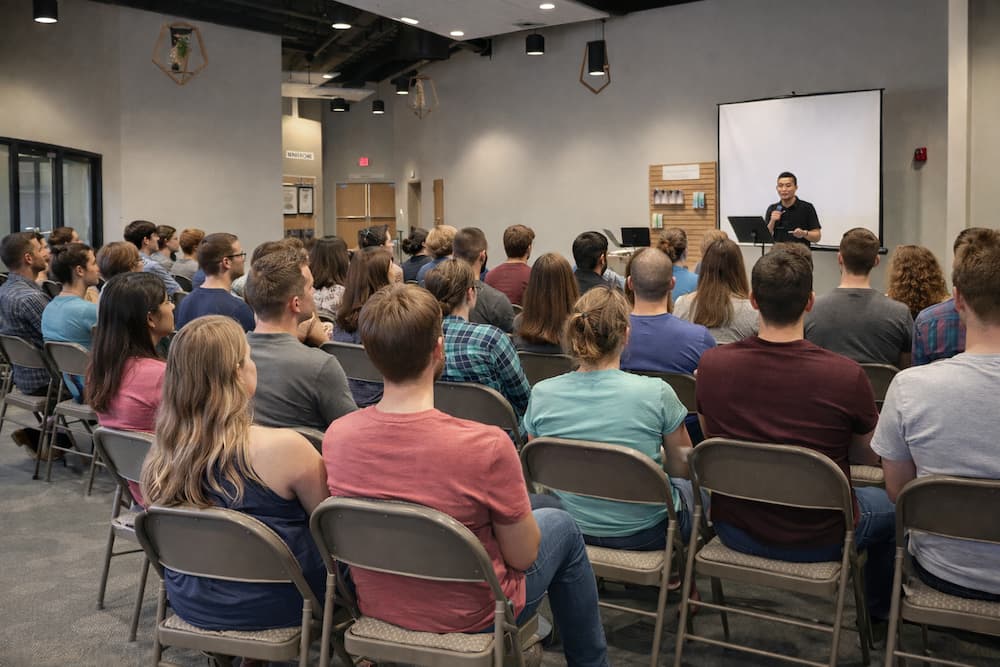Can Technology Convert?
Do you ever wonder what role technology plays in converting unbelievers to believers? In this post, we look at how technology can and is used to grow the Kingdom.

In the 1970s, archaeologist B. Cobbey Crisler and sound engineer Mark Miles took a trip to the Sea of Galilee. Their purpose for the trip - discover how Jesus was heard by thousands of people without any type of voice amplification device. What they found was not only interesting but speaks to our own use of technology today.
They found that the topography of the land, along with the way sound waves travel off the water, carried their own voices around 300 feet (91 meters). It’s not unreasonable to believe that Jesus was aware of this and used this early “technology” to spread the gospel to the crowds who gathered.
Just as Jesus used the means available to him to project his voice, we can also use what’s available to us to declare the Gospel far and wide. Technology is a powerful tool. Chances are you’ve seen it used for both good and bad. Some people feel comfortable with technology in church only up to a certain point. Maybe that’s framed how you feel about technology being used to convert unbelievers to believers. Romans 6:13 commands us to offer every part of ourselves to God instead of to sin. Does that extend to our devices? Let’s take a closer look at using technology as a tool of conversion.
Technology Super Spreader
Most of us are comfortable with the use of technology to share church sermons, bible studies, and helpful articles and blogs. But what about conversion? We seem to get less sure. Is it the sacredness of the act itself? Its importance to the individual as well as to the Church? Maybe you feel that technology is too new to be part of something so...well, old. But just because the technology is new, doesn’t mean the method is.
Let’s look at it like this, in 1455 the Gutenberg Bible was published and released to the public. Before this, reading scripture was not something we regular folks could do. With the technology of their day though, they had access to God’s word in a way that greatly impacted the church. This wasn’t without some push-back. The greater availability of the bible, along with Martin Luther and the 95 theses kick-started the reformation. Arguably one of the most impactful moments of modern church history, and technology played a role.
Now, think about today. YouVersion, BibleGateway, and so many more give you “a million scriptures in your pocket” (sorry Apple). The mobility of the Gospel can only be counted as a good thing. It was true in Gutenberg’s time, and it’s true today. The message of the Bible transcends the means of communication. Whether you’ve experienced it yourself or not, there are people who were led to salvation solely by reading the Bible.
Now, what about the crucial step of sanctification? Technology has been a major player in growing new believers into mature Christians. Even before The Year That Must Not Be Named, online tools and apps have helped people learn and understand their faith in deeper ways. It’s Christ who causes the heart change, but technology can point them to him before and after their salvation.
A New Frontier for Christians
We started in the 1970s, so I found it fitting to finish there. A theological sociologist by the name of Jacques Ellul said back in 1977 said, “What we really need to do is to invent a new technology.” By being at the forefront of innovation and imagination, we hold people captivated by the gospel and use technology for the ultimate good.
It’s part of what we feel pride in at Tithe.ly, using the resources available to us to grow the Church and equip those called by him to spread the Gospel. Our hope is that the church leads the charge in technological advancements. Who knows how many people will come to faith when we create, use, and claim technology for the Kingdom?
Sign Up for Product Updates
In the 1970s, archaeologist B. Cobbey Crisler and sound engineer Mark Miles took a trip to the Sea of Galilee. Their purpose for the trip - discover how Jesus was heard by thousands of people without any type of voice amplification device. What they found was not only interesting but speaks to our own use of technology today.
They found that the topography of the land, along with the way sound waves travel off the water, carried their own voices around 300 feet (91 meters). It’s not unreasonable to believe that Jesus was aware of this and used this early “technology” to spread the gospel to the crowds who gathered.
Just as Jesus used the means available to him to project his voice, we can also use what’s available to us to declare the Gospel far and wide. Technology is a powerful tool. Chances are you’ve seen it used for both good and bad. Some people feel comfortable with technology in church only up to a certain point. Maybe that’s framed how you feel about technology being used to convert unbelievers to believers. Romans 6:13 commands us to offer every part of ourselves to God instead of to sin. Does that extend to our devices? Let’s take a closer look at using technology as a tool of conversion.
Technology Super Spreader
Most of us are comfortable with the use of technology to share church sermons, bible studies, and helpful articles and blogs. But what about conversion? We seem to get less sure. Is it the sacredness of the act itself? Its importance to the individual as well as to the Church? Maybe you feel that technology is too new to be part of something so...well, old. But just because the technology is new, doesn’t mean the method is.
Let’s look at it like this, in 1455 the Gutenberg Bible was published and released to the public. Before this, reading scripture was not something we regular folks could do. With the technology of their day though, they had access to God’s word in a way that greatly impacted the church. This wasn’t without some push-back. The greater availability of the bible, along with Martin Luther and the 95 theses kick-started the reformation. Arguably one of the most impactful moments of modern church history, and technology played a role.
Now, think about today. YouVersion, BibleGateway, and so many more give you “a million scriptures in your pocket” (sorry Apple). The mobility of the Gospel can only be counted as a good thing. It was true in Gutenberg’s time, and it’s true today. The message of the Bible transcends the means of communication. Whether you’ve experienced it yourself or not, there are people who were led to salvation solely by reading the Bible.
Now, what about the crucial step of sanctification? Technology has been a major player in growing new believers into mature Christians. Even before The Year That Must Not Be Named, online tools and apps have helped people learn and understand their faith in deeper ways. It’s Christ who causes the heart change, but technology can point them to him before and after their salvation.
A New Frontier for Christians
We started in the 1970s, so I found it fitting to finish there. A theological sociologist by the name of Jacques Ellul said back in 1977 said, “What we really need to do is to invent a new technology.” By being at the forefront of innovation and imagination, we hold people captivated by the gospel and use technology for the ultimate good.
It’s part of what we feel pride in at Tithe.ly, using the resources available to us to grow the Church and equip those called by him to spread the Gospel. Our hope is that the church leads the charge in technological advancements. Who knows how many people will come to faith when we create, use, and claim technology for the Kingdom?
podcast transcript
In the 1970s, archaeologist B. Cobbey Crisler and sound engineer Mark Miles took a trip to the Sea of Galilee. Their purpose for the trip - discover how Jesus was heard by thousands of people without any type of voice amplification device. What they found was not only interesting but speaks to our own use of technology today.
They found that the topography of the land, along with the way sound waves travel off the water, carried their own voices around 300 feet (91 meters). It’s not unreasonable to believe that Jesus was aware of this and used this early “technology” to spread the gospel to the crowds who gathered.
Just as Jesus used the means available to him to project his voice, we can also use what’s available to us to declare the Gospel far and wide. Technology is a powerful tool. Chances are you’ve seen it used for both good and bad. Some people feel comfortable with technology in church only up to a certain point. Maybe that’s framed how you feel about technology being used to convert unbelievers to believers. Romans 6:13 commands us to offer every part of ourselves to God instead of to sin. Does that extend to our devices? Let’s take a closer look at using technology as a tool of conversion.
Technology Super Spreader
Most of us are comfortable with the use of technology to share church sermons, bible studies, and helpful articles and blogs. But what about conversion? We seem to get less sure. Is it the sacredness of the act itself? Its importance to the individual as well as to the Church? Maybe you feel that technology is too new to be part of something so...well, old. But just because the technology is new, doesn’t mean the method is.
Let’s look at it like this, in 1455 the Gutenberg Bible was published and released to the public. Before this, reading scripture was not something we regular folks could do. With the technology of their day though, they had access to God’s word in a way that greatly impacted the church. This wasn’t without some push-back. The greater availability of the bible, along with Martin Luther and the 95 theses kick-started the reformation. Arguably one of the most impactful moments of modern church history, and technology played a role.
Now, think about today. YouVersion, BibleGateway, and so many more give you “a million scriptures in your pocket” (sorry Apple). The mobility of the Gospel can only be counted as a good thing. It was true in Gutenberg’s time, and it’s true today. The message of the Bible transcends the means of communication. Whether you’ve experienced it yourself or not, there are people who were led to salvation solely by reading the Bible.
Now, what about the crucial step of sanctification? Technology has been a major player in growing new believers into mature Christians. Even before The Year That Must Not Be Named, online tools and apps have helped people learn and understand their faith in deeper ways. It’s Christ who causes the heart change, but technology can point them to him before and after their salvation.
A New Frontier for Christians
We started in the 1970s, so I found it fitting to finish there. A theological sociologist by the name of Jacques Ellul said back in 1977 said, “What we really need to do is to invent a new technology.” By being at the forefront of innovation and imagination, we hold people captivated by the gospel and use technology for the ultimate good.
It’s part of what we feel pride in at Tithe.ly, using the resources available to us to grow the Church and equip those called by him to spread the Gospel. Our hope is that the church leads the charge in technological advancements. Who knows how many people will come to faith when we create, use, and claim technology for the Kingdom?
VIDEO transcript
In the 1970s, archaeologist B. Cobbey Crisler and sound engineer Mark Miles took a trip to the Sea of Galilee. Their purpose for the trip - discover how Jesus was heard by thousands of people without any type of voice amplification device. What they found was not only interesting but speaks to our own use of technology today.
They found that the topography of the land, along with the way sound waves travel off the water, carried their own voices around 300 feet (91 meters). It’s not unreasonable to believe that Jesus was aware of this and used this early “technology” to spread the gospel to the crowds who gathered.
Just as Jesus used the means available to him to project his voice, we can also use what’s available to us to declare the Gospel far and wide. Technology is a powerful tool. Chances are you’ve seen it used for both good and bad. Some people feel comfortable with technology in church only up to a certain point. Maybe that’s framed how you feel about technology being used to convert unbelievers to believers. Romans 6:13 commands us to offer every part of ourselves to God instead of to sin. Does that extend to our devices? Let’s take a closer look at using technology as a tool of conversion.
Technology Super Spreader
Most of us are comfortable with the use of technology to share church sermons, bible studies, and helpful articles and blogs. But what about conversion? We seem to get less sure. Is it the sacredness of the act itself? Its importance to the individual as well as to the Church? Maybe you feel that technology is too new to be part of something so...well, old. But just because the technology is new, doesn’t mean the method is.
Let’s look at it like this, in 1455 the Gutenberg Bible was published and released to the public. Before this, reading scripture was not something we regular folks could do. With the technology of their day though, they had access to God’s word in a way that greatly impacted the church. This wasn’t without some push-back. The greater availability of the bible, along with Martin Luther and the 95 theses kick-started the reformation. Arguably one of the most impactful moments of modern church history, and technology played a role.
Now, think about today. YouVersion, BibleGateway, and so many more give you “a million scriptures in your pocket” (sorry Apple). The mobility of the Gospel can only be counted as a good thing. It was true in Gutenberg’s time, and it’s true today. The message of the Bible transcends the means of communication. Whether you’ve experienced it yourself or not, there are people who were led to salvation solely by reading the Bible.
Now, what about the crucial step of sanctification? Technology has been a major player in growing new believers into mature Christians. Even before The Year That Must Not Be Named, online tools and apps have helped people learn and understand their faith in deeper ways. It’s Christ who causes the heart change, but technology can point them to him before and after their salvation.
A New Frontier for Christians
We started in the 1970s, so I found it fitting to finish there. A theological sociologist by the name of Jacques Ellul said back in 1977 said, “What we really need to do is to invent a new technology.” By being at the forefront of innovation and imagination, we hold people captivated by the gospel and use technology for the ultimate good.
It’s part of what we feel pride in at Tithe.ly, using the resources available to us to grow the Church and equip those called by him to spread the Gospel. Our hope is that the church leads the charge in technological advancements. Who knows how many people will come to faith when we create, use, and claim technology for the Kingdom?




















.jpg)

.jpg)





